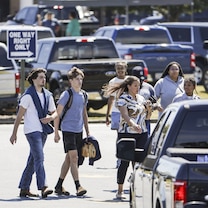Space junk report stresses dangers to satellites, spacecraft
WASHINGTON -- Space junk orbiting Earth, which has disabled satellites and nearly hit the International Space Station, represents a growing threat that NASA needs to deal with better, the National Research Council said in a report released Thursday.
NASA has projected that the amount of debris has reached a "tipping point" in which abandoned equipment, spent rocket bodies and other refuse floating around the planet will continue colliding, threatening spacecraft and satellites.
"The current space environment is growing increasingly hazardous to spacecraft and astronauts," said Donald Kessler, a former head of NASA's orbital debris office who served as chairman of the group of academics and industry officials that wrote the report.
The report found that NASA has used its resources for orbital debris responsibly. But the problem will require international cooperation, and removing existing debris would be expensive, the report said.
"Clearly, we are not doing enough to solve the threat," said Rep. Dana Rohrabacher, R-Calif., who has warned repeatedly about the dangers of space junk. "Although we have reached the tipping point where the problem will get worse and worse, we have no national strategy to eliminate this space garbage."
Federal authorities are tracking 22,000 objects, each at least 10 centimeters long. The risk is that these larger objects, typically traveling more than 20,000 mph, could destroy a satellite or spacecraft.
The amount of debris is growing as more countries launch objects into space.
NASA is developing a capsule called Orion to allow astronauts to escape the International Space Station if there's a catastrophic collision.
Minor collisions are common. The shuttle program replaced an average of two windows after each mission because of collisions with debris.
The National Research Council report, which was sponsored by NASA, urges the agency to better coordinate its debris efforts, because a variety of offices that deal with the issue don't have a single management or budget structure.
"NASA needs to determine the best path forward for tackling the multifaceted problems caused by meteoroids and orbital debris that put human and robotic space operations at risk," Kessler said.
The Defense Department has studied using nets or harpoons to grab larger pieces of space junk. But those techniques haven't been tested in space.
Astronauts have retrieved satellites in the space shuttle's cargo bay, but the shuttle program has ended.
The international goal now is to avoid further explosions that leave debris in space and to have everything launched into orbit fall back to Earth 25 years later.
The U.S. has created 30% of the debris. Because of political rivalries with countries such as Russia and China, the report urges NASA to include the State Department in legal and diplomatic talks to reduce debris.
"The Cold War is over, but the acute sensitivity regarding satellite technology remains," said George Cleghorn, vice chairman of the group that produced the report.




